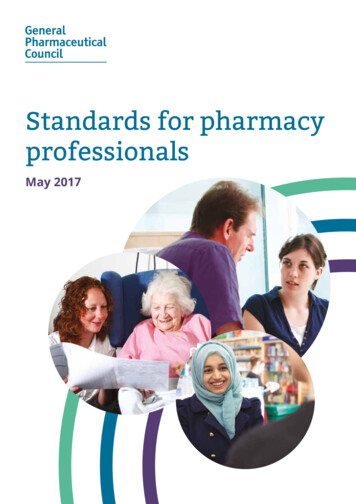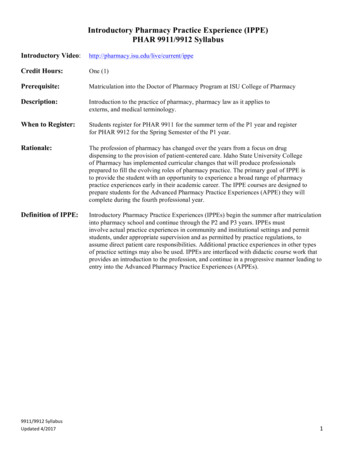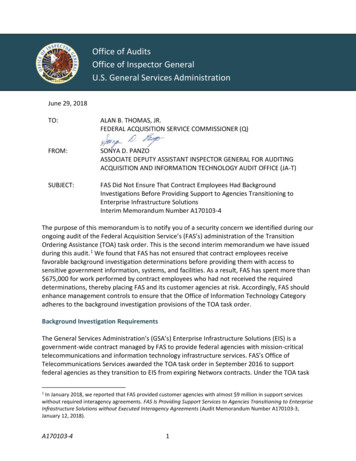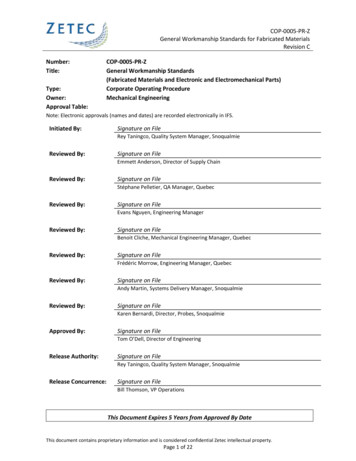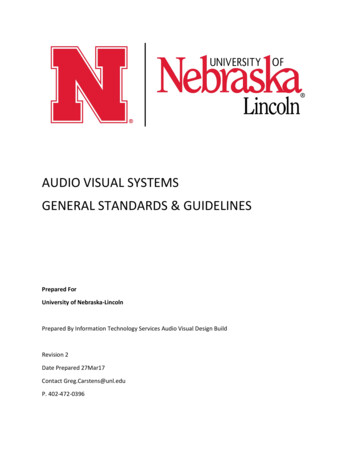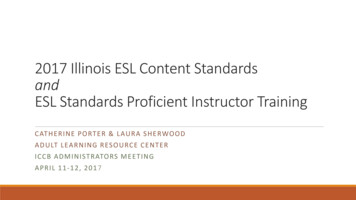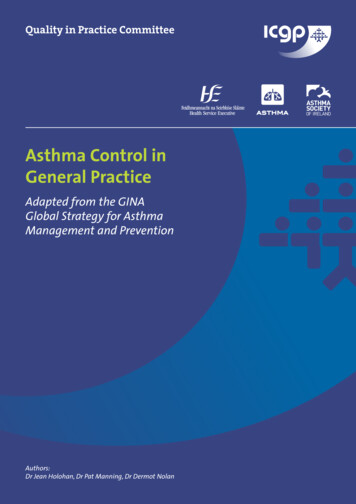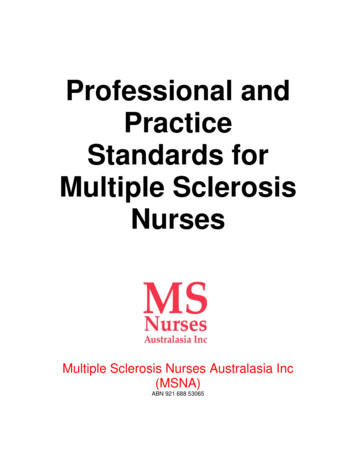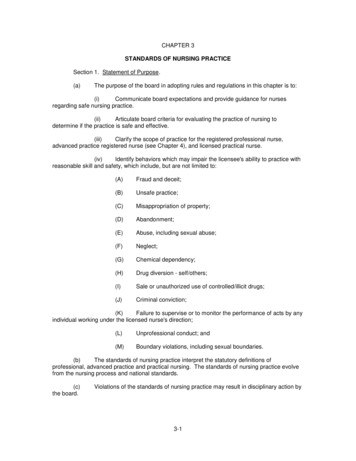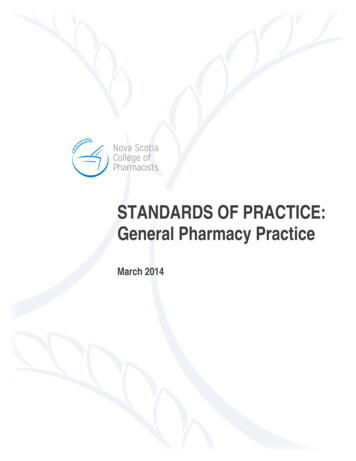
Transcription
Standards of PracticeGeneral Pharmacy PracticeSTANDARDS OF PRACTICE:General Pharmacy PracticeMarch 2014i PageNova Scotia College of PharmacistsMarch 2014
Standards of PracticeGeneral Pharmacy PracticeTable of Contents1 Introduction . 12 Definitions . 23 Standards of Practice . 3Standard 1 Provide Patient Centered Drug Therapy Management . 4Standard 2 Prepare and Distribute Drugs and Devices . 8Standard 3 Manage Patient Information . 12Standard 4 Educate and Provide Drug and Non-Drug Information . 15Standard 5 Participate in the Effective Operations of the Pharmacy . 17Standard 6 Maintain Professional Competence . 20Standard 7 Contribute to Public Health and the Effectiveness of the Health Care System . 214 Appendices .Appendix A – Patient Consent and Disclosure Requirements . 23Appendix B – Documentation Requirements . 27Appendix C – Reference Documents . 29ii P a g eNova Scotia College of PharmacistsMarch 2014
Standards of PracticeGeneral Pharmacy Practice1 INTRODUCTIONThe Pharmacy Act of Nova Scotia states that pharmacists are responsible for the provisionof optimal patient care, including monitoring drug therapy and ensuring the pharmaceuticaland therapeutic appropriateness of drug therapy.The Regulations authorize pharmacists in the province to more fully apply their skills andcompetencies within the health care system as medication therapy experts so as to moreeffectively fulfill the intent and purpose of the Act.The Standards of Practice: General Pharmacy Practice document establishes the clearexpectations of pharmacists with respect to the general practice of pharmacy. It is notintended to be an all-inclusive best practice document, but rather to provide the minimumexpectations for safe and effective care. Pharmacists will undertake the practice ofpharmacy in accordance with these Standards of Practice as well as with existing legislation,regulations, the Code of Ethics, agreements, other standards of practice and policydirectives relevant to pharmacy practice in Nova Scotia. In order for the Standards to beproperly understood and applied, it is important that they be considered in their entirety.The Standards of Practice document is organized into seven overarching Standards. Foreach Standard, the following is set out:1. Standards statement: a statement of the expectations of a pharmacist2. Core Functions: a description of the primary areas of responsibility and functions thatpharmacists perform in order to fulfill the Standard3. Expected Activities: a description of the practice activities that pharmacists areexpected to perform in order to achieve each Core Function4. Examples of Expected Activities: examples of activities that are expected whenobserving the StandardsThis Standards of Practice document was developed by the Nova Scotia College ofPharmacists with the input of many individuals and organizations including the NSCPStandards of Practice Committee, and was informed by the National Association ofPharmacy Regulatory Authorities (NAPRA) Professional Competencies for CanadianPharmacists at Entry to Practice and the NAPRA Model Standards of Practice for CanadianPharmacists.Approved: March 19, 20141 PageNova Scotia College of PharmacistsMarch 2014
Standards of PracticeGeneral Pharmacy Practice2 DEFINITIONSDefinitions for terms represented in the Standards of Practice: General Pharmacy Practiceare provided in the following table.TermDefinitionCare PlanA plan, established by working with the patient when possible, thatsets out the elements of how to manage a patient’s health andmedical condition(s) successfully with drug and non-drug therapy andincludes all of the work necessary to accomplish this. The planincludes goals of therapy, interventions to address drug therapyproblems (DRPs) and a plan for monitoring and follow-up.Circle of CareIncludes individuals involved with, and activities related to, the careand treatment of a patient. It includes the health care providers whodeliver care and services for the primary therapeutic benefit of thepatient, and those who provide related services such as laboratorywork and professional or case consultation.(From the Personal Information Protection and Electronic Documents Act (PIPEDA) AwarenessRaising Tools and Personal Health Information Act (PHIA) Toolkit).DocumentationDocumentation can be in paper or electronic form. The extent andform of documentation may vary depending on what is required in theStandards.E-PrescriptionA prescription that has been created, signed and transmittedelectronically within the provincial DIS.Evidence informedThe conscientious, explicit and judicious use of current best evidencein making decisions about the care of an individual patient, whileincorporating the expertise of the pharmacist and the preferences,rights and specific attributes of the patient. 2, 3Patient’s AgentFor the purpose of these Standards, each time there is a reference tothe patient it means the patient or their agent as defined in thePharmacy Act of 2011.Patient Record2 PageA complete reference of all documentation and information related tothe care of a patient that includes: prescription records, medicationprofiles, and patient profiles.Nova Scotia College of PharmacistsMarch 2014
Standards of Practice3General Pharmacy PracticeSTANDARDS OF PRACTICEThe following chart represents a high level description of the primary elements of the Standardsof Practice. This Standards document is based on, and inextricably linked to, ProfessionalCompetencies for Canadian Pharmacists at Entry to Practice and the Pharmacy Act.StandardCore Functions1. Provide PatientCentered DrugTherapyManagement1.11.21.31.4Assess the patient’s needs, concerns and health statusDevelop a care planSupport the patient to implement the care planMonitor the patient’s progress with the care plan2. Prepare andDistribute Drugsand Devices2.12.22.32.42.52.6Receive PrescriptionsPrepare productsDistribute drug preparations and productsMaintain records of preparation and distributionStore drug preparations and productsDispose of drug preparations and products3. Manage PatientInformation3.1 Ensure the confidentiality of all forms of patient information3.2 Document and manage patient information3.3 Ensure the safety and security of records4. Educate and ProvideDrug and Non-drugInformation4.1 Educate to support and promote health4.2 Contribute to the education and training of learners, i.e.,pharmacy students, interns, residents and technicians5. Participate in theEffective Operationsof the Pharmacy5.1 Oversee the pharmacy practice environment5.2 Oversee the human resources within the practice5.3 Oversee the pharmacy’s operational systems and processes6. MaintainProfessionalCompetence6.1 Plan and implement professional development strategies tomaintain professional competence7. Contribute toSocietal Health andthe Effectiveness ofthe Health CareSystem7.1 Promote health in the community7.2 Advocate and support policies that promote improved healthoutcomes, public safety and the viability of the healthcare system7.3 Develop, maintain and promote collaborative relationships withhealth care providers and others3 PageNova Scotia College of PharmacistsMarch 2014
Standards of PracticeGeneral Pharmacy PracticeStandard #1: Provide Patient Centered Drug Therapy ManagementPharmacists, in collaboration with colleagues, patients and other health care professionals, use their unique knowledge and skills to supportthe patient on an ongoing basis in meeting their drug and health related needs to achieve optimal health outcomes.Standards of Practice:Core FunctionExpected Activities1.1 Assess the patient’sneeds, concerns andhealth status4 PageExamples of Expected Activities1.1.1 Establish andmaintain a professionalrelationship with thepatient Make best efforts to establish trust and respect Respect and protect patient confidentiality Clarify and communicate to the patient the roles, responsibilities andaccessibility of the pharmacist Provide a safe, private and quiet environment to encourage the patient toexpress any needs, views and concerns Maintain a professional and caring attitude, and respect the patient’s choicesand preferences Determine and respect the extent of a patient’s involvement in their care Allocate time to respond to the patient’s relevant health questions Identify, evaluate and address barriers to communication1.1.2 Gather relevantinformation about thepatient Determine the patient’s relevant clinical information as appropriate, including: Current symptoms/indication for treatment, medical conditions,medications, non-medication therapies, healthcare products/devices andtreatments Physical characteristics and measurements (e.g. weight, height, age/agegroup, etc.) Laboratory or other diagnostic test results Date of and findings from the pharmacist's assessment of the patient,including those findings presented/reported by the patient (subjective)and those observable and measurable by the pharmacist (objective) Adverse drug reaction experienced by the patients, allergies, orsensitivities Other health care professionals and caregivers involved in providingtreatment and care Family medical history, as applicableNova Scotia College of PharmacistsMarch 2014
Standards of PracticeCore FunctionGeneral Pharmacy PracticeExpected ActivitiesExamples of Expected Activities Personal circumstances, practical needs, values and preferences, lifestyleand financial factors where applicable Other information relevant to assessing the appropriateness of drugtherapy and/or the pharmacy service being provided1.2 Develop a care plan5 Page1.1.3 Determine thepatient’s desired healthand therapeutic outcomesand priorities 1.2.1 Interpret andevaluate prescriptions Take all reasonable steps to ensure the appropriateness of drug therapy,including but not limited to: conversations with the patient, reviewing thepatient’s profile and information gathered, considering all notificationsgenerated by the pharmacy software1.2.2 Identify care planoptions and makerecommendations to meetthe patient’s needs Appropriately review, analyze and interpret information and data aboutpatient’s health status Identify and prioritize actual and potential drug therapy problems Establish options to address drug therapy problems that are evidenceinformed and reflect accepted and current practice Provide options that are relevant to patient’s expectations, needs, priorities,values and limitations Discuss options collaboratively with colleagues and other health care providerswhere applicable Make recommendations to the patient that aim to optimize their desiredhealth outcomes1.2.3 Support the patientto select care plan options Provide appropriate information about expected benefits, efficacy, side effectsand toxicity, and/ or potential interactions in a manner that supports patientdecision-making Respond to the patient’s questions, concerns and choices appropriately andrespectfully Establish the patient’s priorities, health needs, desired level of care andexpectations of therapyEncourage the patient to ask questions and describe concernsDiscuss financial considerations with the patient as appropriate and takereasonable steps to manage any associated drug therapy problemsNova Scotia College of PharmacistsMarch 2014
Standards of PracticeCore Function1.3 Support the patientto implement the careplan6 PageGeneral Pharmacy PracticeExpected ActivitiesExamples of Expected Activities1.2.4 Refer the patient toservices when appropriate Maintain current knowledge of healthcare providers, services and communityresources to which patients could be referred Make referrals, when appropriate, so as to optimize the patient’s healthoutcomes Make referrals to other providers when the pharmacist does not have theknowledge, skills and competencies necessary to effectively address thepatient’s needs1.3.1 Counsel the patient Communicate with the patient at a level appropriate for the patient’s level ofunderstanding Dialogue with the patient to confirm their understanding of the care plan andwhere appropriate, obtain their informed consent (refer to Appendix A Patient Consent and Disclosure Requirements) Provide and discuss adherence tools and options with the patient whereappropriate Provide appropriate supplemental information to further support the patientwhen appropriate Include the following, as appropriate, when counselling a patient: Confirmation of the identity of the patient Name and purpose of the drug being dispensed Directions for proper use, including education about devices Common or important drug-drug or drug-food interactions How the patient should monitor the anticipated therapeutic response,including the associated time frames for therapeutic effect Common side effects, adverse reactions, interactions and therapeuticcontraindications, including their avoidance, and the actions required ifthey occur Actions the pharmacist will undertake to monitor the patient’s progress,when appropriate Actions the patient should take if the intended therapeutic response is notobtained Refill (including part-fill) information and any other
pharmacy in accordance with these Standards of Practice as well as with existing legislation, regulations, the Code of Ethics, agreements, other standards of practice and policy directives relevant to pharmacy practice in Nova Scotia. In order for the Standards to be properly understood and applied, it is important that they be considered in their entirety . The Standards of Practice document .
